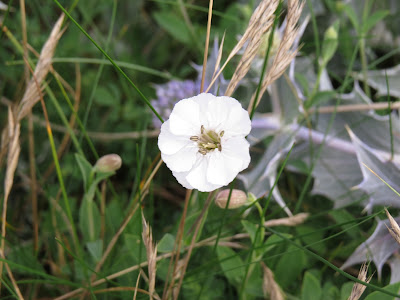I had two oktas cloud cover with a 15 mph northwesterly wind as I set off on my walk. Nothing to do with birds but I didn't half see a lot of Rabbits this morning. After a while I counted them as I walked round and I had 33 in total! I have never seen that many here before and unlike a lot of our passerine birds they must have produced a good number of young.
Whilst off the subject of birds, not that I've got started on the birds yet, some of the coastal wildflowers were showing very well this morning. In some of the fields behind the sea wall I had plenty of Strawberry Clover (although I think it should have been named Raspberry Clover as it looks more like a Raspberry!) alongside it's planer cousins of White and Red Clover.
Strawberry Clover
I came across a nice stand of Teasels with plenty of bees foraging on the flowers, although most of them were past their best, but they will soon provide a great source of seeds for Goldfinches and Linnets.
A nice stand of Teasels
Bumblebee on a Teasel flower
Amongst the dune grassland was a sea of Sea Holly, and like the Rabbits the most I have ever seen here, and nestled amongst the Sea Holly were some Sea Campion and Biting Stonecrop.
Part of the sea of Sea Holly
Sea Holly close up
Sea Campion
Biting Stonecrop
Now to the birds. I didn't get the impression that there were any grounded migrants this morning and I felt that the Whitethroat and four Sedge Warblers I had were local birds. There's plenty of Creeping Thistle seeding at the moment and I came across a flock of 35 Goldfinches feeding on the seed heads.
Whitethroat
Raptors were represented by two females this morning, a female Sparrowhawk and a female Kestrel, presumably one half of the local breeding pair. I couldn't really detect any 'vis' this morning other than perhaps two House Martins and a single Swallow winging their way south.
Male Common Blue
On the fields were five Whimbrels with six of their larger Curlew cousins and that was it for waders other than a single Ringed Plover and nine Oystercatchers. I didn't spend long looking at the sea and consequently all I had were ten Sandwich Terns and two Common Terns.
It's dawn and dusk ringing for me tomorrow, with hopefully migrant warblers in the willow scrub in the morning and roosting Swallows in the reedbed in the evening. Now you'll have to excuse me while I go and get a beer!









No comments:
Post a Comment